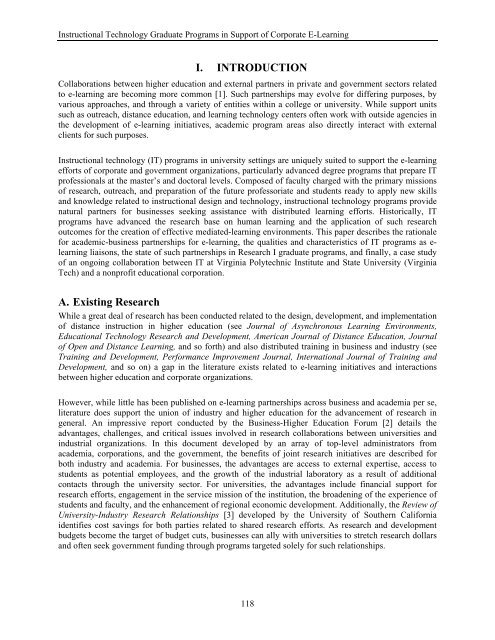Elements of Quality Online Education cation
Elements of Quality Online Education cation
Elements of Quality Online Education cation
Create successful ePaper yourself
Turn your PDF publications into a flip-book with our unique Google optimized e-Paper software.
Instructional Technology Graduate Programs in Support <strong>of</strong> Corporate E-LearningI. INTRODUCTIONCollaborations between higher edu<strong>cation</strong> and external partners in private and government sectors relatedto e-learning are becoming more common [1]. Such partnerships may evolve for differing purposes, byvarious approaches, and through a variety <strong>of</strong> entities within a college or university. While support unitssuch as outreach, distance edu<strong>cation</strong>, and learning technology centers <strong>of</strong>ten work with outside agencies inthe development <strong>of</strong> e-learning initiatives, academic program areas also directly interact with externalclients for such purposes.Instructional technology (IT) programs in university settings are uniquely suited to support the e-learningefforts <strong>of</strong> corporate and government organizations, particularly advanced degree programs that prepare ITpr<strong>of</strong>essionals at the master’s and doctoral levels. Composed <strong>of</strong> faculty charged with the primary missions<strong>of</strong> research, outreach, and preparation <strong>of</strong> the future pr<strong>of</strong>essoriate and students ready to apply new skillsand knowledge related to instructional design and technology, instructional technology programs providenatural partners for businesses seeking assistance with distributed learning efforts. Historically, ITprograms have advanced the research base on human learning and the appli<strong>cation</strong> <strong>of</strong> such researchoutcomes for the creation <strong>of</strong> effective mediated-learning environments. This paper describes the rationalefor academic-business partnerships for e-learning, the qualities and characteristics <strong>of</strong> IT programs as e-learning liaisons, the state <strong>of</strong> such partnerships in Research I graduate programs, and finally, a case study<strong>of</strong> an ongoing collaboration between IT at Virginia Polytechnic Institute and State University (VirginiaTech) and a nonpr<strong>of</strong>it edu<strong>cation</strong>al corporation.A. Existing ResearchWhile a great deal <strong>of</strong> research has been conducted related to the design, development, and implementation<strong>of</strong> distance instruction in higher edu<strong>cation</strong> (see Journal <strong>of</strong> Asynchronous Learning Environments,<strong>Edu<strong>cation</strong></strong>al Technology Research and Development, American Journal <strong>of</strong> Distance <strong>Edu<strong>cation</strong></strong>, Journal<strong>of</strong> Open and Distance Learning, and so forth) and also distributed training in business and industry (seeTraining and Development, Performance Improvement Journal, International Journal <strong>of</strong> Training andDevelopment, and so on) a gap in the literature exists related to e-learning initiatives and interactionsbetween higher edu<strong>cation</strong> and corporate organizations.However, while little has been published on e-learning partnerships across business and academia per se,literature does support the union <strong>of</strong> industry and higher edu<strong>cation</strong> for the advancement <strong>of</strong> research ingeneral. An impressive report conducted by the Business-Higher <strong>Edu<strong>cation</strong></strong> Forum [2] details theadvantages, challenges, and critical issues involved in research collaborations between universities andindustrial organizations. In this document developed by an array <strong>of</strong> top-level administrators fromacademia, corporations, and the government, the benefits <strong>of</strong> joint research initiatives are described forboth industry and academia. For businesses, the advantages are access to external expertise, access tostudents as potential employees, and the growth <strong>of</strong> the industrial laboratory as a result <strong>of</strong> additionalcontacts through the university sector. For universities, the advantages include financial support forresearch efforts, engagement in the service mission <strong>of</strong> the institution, the broadening <strong>of</strong> the experience <strong>of</strong>students and faculty, and the enhancement <strong>of</strong> regional economic development. Additionally, the Review <strong>of</strong>University-Industry Research Relationships [3] developed by the University <strong>of</strong> Southern Californiaidentifies cost savings for both parties related to shared research efforts. As research and developmentbudgets become the target <strong>of</strong> budget cuts, businesses can ally with universities to stretch research dollarsand <strong>of</strong>ten seek government funding through programs targeted solely for such relationships.118
















